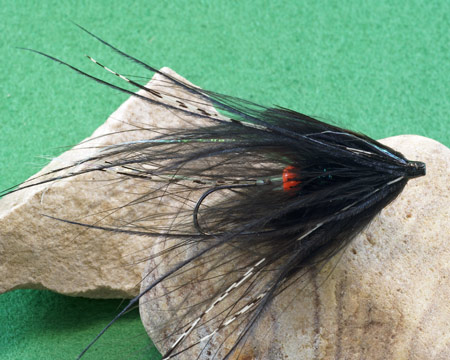King’s Hot Butt Prawn-Black
Designed by Matt King

Tube: HMH Plastic Tube, Small
Thread: MFC 6/0 Black
Bead: Hot Bead, Orange, Large, ¼”
Hackle: Saddle Hackle, Black
Body: Crystal Chenille, Medium or Medium Large, Black
Collar: Marabou, Black, followed by 10-12 Pieces of Ostrich Herl, Black and 6-8 Natural Amherst Tail Fibres
Flash: Flashabou, Twisted, Pearl or Crinkle Mirror Flash
Carapace: Golden Pheasant, Black (optional)
A tube fly is nothing more than a fly tied onto a tube as opposed to a traditional hook shank. Modern tube flies trace their history back to the late 1940’s, just after World War Two. Actual tube fly history traces its roots even further. Northwest first nation’s anglers used tube flies tied onto feather quills for Pacific salmon. Tube flies are popular with Atlantic salmon fly fishers and have become popular pattern selections for West Coast steelhead fly fishers as well. Tube flies are also excellent choices for saltwater and freshwater tying applications but for some reason have yet to experience the popularity they do with their anadromous brethren. Some creative fly tyers have adapted a modular approach to their tube flies creating interchangeable head and tail sections to adapt to a variety of presentation challenges. This approach works well with certain nymph patterns such as damselflies and large baitfish designs. Tube flies can also be stacked end to end forming large flowing articulated patterns perfectly suited for quarry that prefer large meals.
So why would someone want to use a tube fly anyway? Well from a practical perspective tube flies offer a number of advantages. One of the challenges of tying big flies is the leverage issues large hooks cause. Tube fly size is not affected by hook size. Tube flies use small, tough to shake loose, straight eye short shank hooks that greatly increase your landing ratio. The short shank hooks reduce both fly and fish mortality. Fish are not in danger of mortally wounding themselves on large hooks and as the tube fly slides away from the fish its lifespan increases, safe from the perils of ravaging teeth. Should a hook become damaged or corroded it can easily be changed without having to replace the pattern.
To view the rest of this article, please login or join now for free!
|



